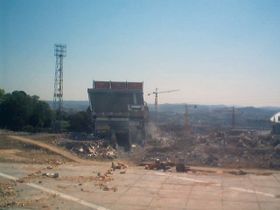 Stadium inauguration in 1952 Stadium inauguration in 1952 | |
| Full name | Estádio do Futebol Clube do Porto |
|---|---|
| Location | Avenida Fernão de Magalhães, Porto |
| Capacity | 55,000 |
| Construction | |
| Opened | 28 May 1952 |
| Closed | March 2004 |
| Architect | Oldemiro Carneiro |
| Tenants | |
| FC Porto (1952–2004) | |
The Estádio das Antas (pronounced [ɨʃˈtaðju ðɐz ˈɐ̃tɐʃ]; officially Estádio do Futebol Clube do Porto [ɨʃˈtaðju ðu futɨˈβɔl ˈkluβɨ ðu ˈpoɾtu]) was the third (and longest occupied) stadium of the Portuguese football side FC Porto. It was in use from 1952 to 2004, replacing the earlier Campo da Constituição, 1.6km (1 mile) to the west, and later replaced by the Estádio do Dragão, a block southeast away. As well as the stadium, it had an indoor arena and three training grounds. The club's offices were also split between the inside of the stadium and the Torre das Antas, built in front of the stadium during the 1990s. It was demolished in 2004, although one floodlight still remains, and the majority of the site is not yet redeveloped.
Layout
The stadium was split into six different areas. The Poente and Maratona contained the best seats, while the most financially accessible were located in the Superior Norte, Superior Sul and Arquibancada. Between the Norte and Poente were seats for the away supporters. Each stand was split into different sectors. While the Poente had four, both Maratona and Arquibancada had five, and both Superiores (upper tiers) had nine, but two in Norte were reserved for away supporters. For matches, low turnout from away fans, in contrast to that expected from Porto supporters, so the away fan sector was often reduced in size by half. In the past there were other divisions, such as splitting the Superior stands between the original and the new terraces built after the 1986 capacity increase.
Portugal national football team
The national team first played in the stadium in 1952 and held its last game there in 2003.
| # | Date | Score | Opponent | Competition |
|---|---|---|---|---|
| 1. | 23 November 1952 | 1–1 | Friendly | |
| 2. | 22 May 1955 | 3–1 | Friendly | |
| 3. | 28 June 1959 | 3–2 | Euro 1960 First Round | |
| 4. | 15 November 1964 | 2–1 | Friendly | |
| 5. | 24 June 1965 | 0–0 | Friendly | |
| 6. | 31 October 1965 | 0–0 | World Cup 1966 qualification | |
| 7. | 3 July 1966 | 1–0 | Friendly | |
| 8. | 12 November 1967 | 2–1 | Euro 1968 qualifying | |
| 9. | 4 May 1969 | 2–2 | World Cup 1970 qualification | |
| 10. | 12 May 1971 | 5–0 | Euro 1972 qualifying | |
| 11. | 12 November 1975 | 1–1 | Euro 1976 qualifying | |
| 12. | 16 October 1976 | 0–2 | World Cup 1978 qualification | |
| 13. | 15 April 1981 | 1–1 | Friendly | |
| 14. | 20 June 1981 | 2–0 | Friendly | |
| 15. | 14 October 1984 | 2–1 | World Cup 1986 qualification | |
| 16. | 11 November 1987 | 0–0 | Euro 1988 qualifying | |
| 17. | 17 October 1990 | 1–0 | Euro 1992 qualifying | |
| 18. | 20 February 1991 | 5–0 | Euro 1992 qualifying | |
| 19. | 4 September 1991 | 1–1 | Friendly | |
| 20. | 11 September 1991 | 1–0 | Euro 1992 qualifying | |
| 21. | 24 February 1993 | 1–3 | World Cup 1994 qualification | |
| 22. | 13 October 1993 | 1–0 | World Cup 1994 qualification | |
| 23. | 3 June 1995 | 3–2 | Euro 1996 qualifying | |
| 24. | 3 September 1995 | 1–1 | Euro 1996 qualifying | |
| 25. | 21 February 1996 | 1–2 | Friendly | |
| 26. | 9 November 1996 | 1–0 | World Cup 1998 qualification | |
| 27. | 7 June 1997 | 2–0 | World Cup 1998 qualification | |
| 28. | 10 October 1998 | 0–1 | Euro 2000 qualifying | |
| 29. | 28 March 2001 | 2–2 | World Cup 2002 qualification | |
| 30. | 29 March 2003 | 2–1 | Friendly |
Milestones

- 28 May 1952 – Inaugurated in the presence of Portuguese President General Craveiro Lopes.
- 1 September 1962 – Floodlights.
- 1973 – All-purpose arena completed.
- 30 April 1976 – Construction of Maratona stand, on the opposite of the main stand, and start of the Arquibancada.
- 16 December 1986 – capacity increased to 95,000 (rebaixamento). (Athletics track removed)
- Summer 1997 – All-seater (capacity reduced to 48,297 seats).
- 24 January 2004 – Final game. Although the successor Estádio do Dragão had opened in November 2003, the replanting of the turf resulted in some games returning to Estádio das Antas.
- March 2004 – Demolition began.
External links
| Futebol Clube do Porto | |
|---|---|
| Other teams | |
| Stadiums | |
| Indoor arenas |
|
| Training grounds |
|
| Other facilities | |
| Media |
|
| Supporters |
|
| Rivalries | |
| Other sports |
|
| Adapted sports |
|
| Affiliated clubs | |
| Related articles | |
41°9′53.7″N 8°35′13.1″W / 41.164917°N 8.586972°W / 41.164917; -8.586972
Categories: